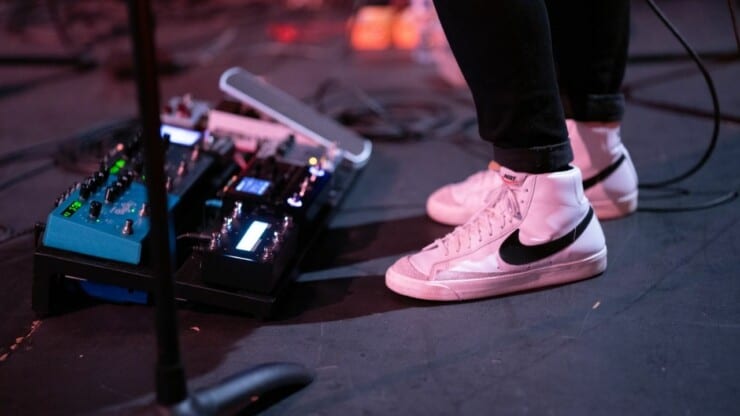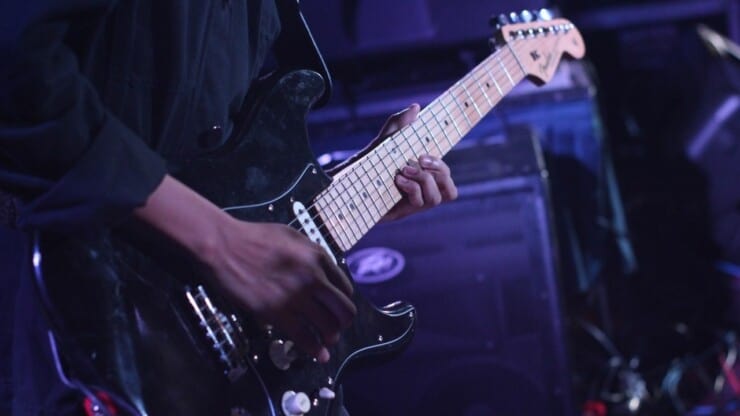Are you looking to get the sweet distortion sound without using distortion pedals? The good thing for you is that it’s actually possible, and you’ll get to know how.
Distortion on guitar without pedal is possible by using the controls on the amp for creating the distortion. In certain cases, pedals create less distortion due to the way they scramble the tone, but using the amp will give you terrific distortion.
In this article, you’ll get to know all about distortion, why does it sound so good, how to get distortion on guitar without pedal, different reasons why you must include distortion in your guitar, and more. Continue reading to get all the answers you’re looking for.
Distortion in the guitar
Distortion is essentially an audio phenomenon that is caused when the input signal is a bit too high for the output. In most audio applications, distortion is considered undesirable. Moreover, audiophiles go to extreme lengths to get the audio setup of distortion-creating characteristics.
But for guitarists, distortion can be a blessing, a source of great joy. The crunch that distortion gives to the guitar will add attitude and character to your tone. Distortion pedals will alter the signal from the guitar to emulate the desirable characteristics of distortion. In case you don’t have a distortion pedal, you can still create natural distortion using the amp.
Why does distortion sound so good on a guitar?
From a scientific viewpoint, distortion sounds good because it adds the character and harmonics that wasn’t present previously. The sound will be thickened, but the distortion’s harmonics won’t be too harsh on the ear as they may be if you were distorting another instrument like the piano.
A decent quality distortion pedal with properly build circuitry can potentially make the difference. The sound will be compressed, which means the volume of the strums and notes will sound closer together. Meanwhile, the notes will ring out for longer before the volume starts falling. It can be a powerful tool for chords and soloing.
Another potential reason is that the human ear has gotten used to distorted sound. Many genres are intrinsically linked with distorted sounds to the point that you’re no longer used to hearing dry sounds. Rock, Heavy Metal, Alternate, and even Pop music make use of the distorted sound. This means that you are almost hard-wired to expect distortion.
As a guitarist, you’ll find that there’s an abundance of tones that you’ll discover if you use a distortion pedal. It doesn’t even have to be an expensive one, you can find several new tone prospects with an inexpensive pedal. It’ll add another dimension and darker tones that you might wish to use in your music. Although most people can agree that distortion is a powerful tool, there is still a lot to learn about it.
How to get distortion on guitar without a pedal?
It is possible to distort a guitar without actually using a pedal. This can be done by using the controls on the amp and creating distortion. Most amps these days come with channels and controls that provide the dirty distorted sound without a pedal.
It isn’t an obligation to own or use a pedal for creating distortion. Moreover, some pedals create less distortion, mainly due to the way they artificially scramble a natural tone of the guitar. This is the case mainly due to the way they scramble the natural tone of the guitar. To have a pedal that will give terrific effects, you might have to pay a bit more.
Moreover, many musicians claim that they choose natural distortion for a recording studio, as the effect sounds more beautiful than what is created by distortion pedals. The truth is, you’ll be able to reach this effect with just the amp if you’re using the right amp. There are a couple of factors that will impact how the amp is creating distortion.
Amp size
The size of the amp will be a key factor in creating distortion. The lower the wattage, the better will be the distortion. It’s slightly weird as people think that strong, massive sounds from rock recordings come with huge, mighty gadgets. The circuitry in lower-watt amps will allow the signal to break faster than in cleaner, high-wattage models.
Many mega tones of Led Zeppelin’s recordings came through a single 12-inch speaker. A smaller amp is capable of delivering flawless distortion.
If you need something bigger for handling live performances on the big stage, you should prefer using an amp with master-volume settings. Otherwise, you will struggle to get heard if you’re playing through a small amp. There could be a chance that you destroy it.
Amp type
A great way of natural distortion on the amp is to get an old, vintage amp. Their power technology isn’t as good as the modern models, but it makes them easier to distort.
Moreover, tube amps will be the best medium for producing natural distortion. The distortion coming from the tube amp will be warm, round, and easy to harness. The perfect amp type will depend on what distortion type you’re looking to achieve. Although a vintage amp will distort quickly, if you’re looking for the 90s tones, you will not like it.
Different ways to get distortion without a pedal
You can distort the amp without having a guitar pedal by using the distortion channel on the amp. This way, you’ll be creating a natural distortion. You can even change the pickups or play with a palm muting. These methods will help you make the distortion sound really sweet. Even some musicians and guitarists create distortion without pedals when performing live or recording in the studio.
What’s more important is that you should have the right am. Get one with a lower-wattage or higher-wattage with master-volume settings and the specific amp type that can produce accurate distortion. Another important thing is your playing technique and combining it with the right amp. This will help you get the best possible effect. Here are the different ways of how to get distortion on guitar without a pedal.
Create distortion using the amp’s distortion channel
You can turn the amp’s overdrive pedal to create distortion without a pedal. Moreover, you can turn on the amp’s overdrive channel to achieve this. It is generally called crunch or drive, depending on the amp you’re using. By turning it on, you’ll overdrive the tubes of the amp and instantly get a nice crunch without actually using the pedal. The overdrive level or type will vary, and it isn’t the same on all the amps. After you’ve turned up the gain, you should check the volume channel and then adjust it to a comfortable level. However, ensure that you aren’t using too much volume.
Create distortion using the amp’s volume channel
You can always force the amp to create natural distortion even if it doesn’t have an overdrive channel by turning up the volume. While the amp is switched off, you should turn the master volume down all the way. Then, you should turn up the gain while setting the volume channels to the maximum. Turn the guitar volume up while setting the pickup selector to the bridge pickup. Turn on the amp and then play the Low E string. Lastly, turn the master volume until you’re hearing the distortion.
Create distortion using bridge pickups
You can play with the pickup selector set to the bridge pickup if you’re looking to create distortion without pedals. Moreover, you can replace the stock ones with higher-output options if you’re looking to get more distortion thanks to pickups.
Create distortion with palm muting
If you’re playing with palm muting with the gain turned up, it’ll also create a bit of distortion. It’ll clip the signal addressed from the guitar to the amp.
Using the right equipment
Different guitars will come with different sounds. Moreover, some amps will give you a nice effect that you’d actually want. If you’re looking to get a chorus running effect, you must consider playing a 12-string guitar. Moreover, the mini guitar will be great for getting the same effect as running parametric equalizers.
You can even change strings for a different sound and the distortion effect that you need. Moreover, tuning can sometimes help in getting the desired effect. Re-tuning the 12-string to anything other than octaves will be equivalent to using a pitch shifter or harmonizer.
When talking about the amps, it’ll be important for you to find the right amp if you’re looking to achieve the effect of distortion without using the pedals. It must be a lesser-wattage one and, if possible, a tube.
Playing techniques
Guitar effects like distortion can be created using a decent guitar, a quality amp, and some experimenting. Not just distortion, you can get other effects as well. For instance, if you’re looking for the tremolo effect, you can produce that effect by rocking the volume knob back and forth. You can then use your pinky finger for doing it quickly. If you’re looking to get a vibrate, rock the fretting hand back and forth. You should try to push and pull on the neck. You’ll have to get a bit aggressive in your playing to get that effect. This will require a bit of experimentation and practice, but must remember that everything is possible.
How to get the distortion effect in cheap amps?
Even if you have a cheap amp, you can still get the distortion effect by adjusting the settings. You should turn the gain down for reducing the crackling noise and use bridge pickups to get the distortion.
A cheap, solid-state amp will give you the crackling noise when you’ve turned the gain up. You should try to adjust the knob and reduce the gain until you’ve gotten rid of the noise. Another way of cutting the extra gain would be by turning the guitar volume a bit down.
Moreover, consider changing the pickups and combining playing with palm mute to get a better-distorted sound. You cannot learn to tweak the tone overnight, but you’ll eventually get there. This will make even the cheapest amps sound considerably better, and make expensive amps sound even more expensive.
There are many cheap amps that’ll give you terrific sound and distortion coming out of them, even if they cost less than $500. Ultimately, it’ll be all about the settings and your personal preferences.
5 key reasons to add distortion to your guitar
It might seem that distortion only makes the guitar playing sound worse, especially for beginners. However, this isn’t the case. You should always start by including a moderate amount of distortion to the guitar sound (around half a dial). Then, work from there. You don’t always need to have it in full (but there isn’t any problem if you prefer that sound).

Adding distortion to the guitar tone isn’t just useful to give a more rock sound, it’ll also help in tidying up your playing in a clean tone too. Generally, guitarists think of electric guitars when talking about distortion. However, if you’re using an electro-acoustic, you can also add distortion to the sound as well if you’re playing through an amp. Here are five key reasons why you must add distortion to your guitar sessions.
1. It’ll amplify everything
Using distortions during your guitar sessions will amplify everything you’re playing. Not only the intentional notes will get louder, but the open strings that you don’t want will be amplified too. Using distortion will help you find the notes that aren’t pulling their weight and should not be there.
2. When practicing bends
Distortion will help you hold the guitar bands for longer, as they’ll keep ringing with less volume.
When practicing unison bends distortion, it’ll highlight the differences between the guide notes and the notes you’re bending more using a clean tone. By using distortion to help you hear when the band has reached the correct pitch, it’ll also mean that the bends are better in a clean note as well as a distorted tone.
3. When practicing chords and tidying up the clean tone guitar playing
Distortion will help you clean up the chords. If the open chords and 5-string barre chords sound slightly off, you might be hitting extra strings that you don’t want to hear.
You should turn the distortion down to almost a quarter on the dial, such that it isn’t hiding your mistakes. It’ll help you highlight the extra ringing notes.
Try to play the open chords in a strumming pattern. You could find after a few chords that it has started sounding slightly muddy and the chords aren’t as defined as you’d like. You’re probably hitting a few extra low-open strings. This will make the chords less defined while making them sound messy.
The distortion will help you sustain the notes so that you’re able to hear the extra notes easily. You can also work on missing them. This helps improve the chords with a clean tone too.
4. You need to work harder to make the guitar play clean with a distorted sound
With more distortion, there will be more string noise. You’ll need to get better at muting out the extra strings with both your right and left hand, as they’ll continue ringing longer than in a clean tone. After practicing with distortion and tidying the playing, you’ll continue using the same techniques with the clean notes. After practicing, you’ll find that the clean-tone guitar riffs are crisper than before.

5. It helps in sustaining notes
While many guitarists use volume and sustain pedals for helping them keep the notes ringing, even a small amount of distortion will help with sustaining the notes for longer. This will be useful when you’re learning melodies or guitar solos.
So, you should go ahead and try to add some distortion to your next guitar practice session. You might even find that using distortion helps speed up your progress. You’ll be able to improve in a short span of time. This is possible as you’ll hear extra noises far easier than before.
Conclusion
Thank you for reading. Hopefully, now you know a lot more about distortion, why does it sound so good, how to get distortion on guitar without pedal, different reasons why you must include distortion in your guitar, and more. Getting the distortion effect on your guitar without the distortion pedal is actually possible, and it’s easier than you think. You can achieve this effect by multiple methods. The most common method is by using the controls on the amp to create distortion. Using the amp will give you terrific distortion, which will sometimes be better than what you’d get with a distortion pedal.



